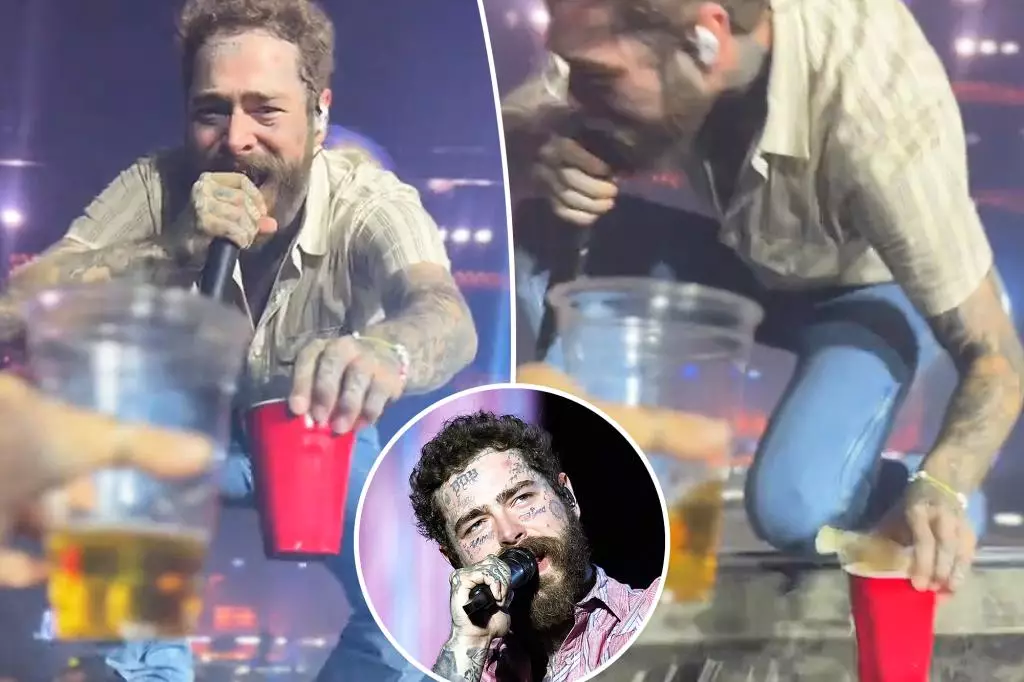Live performances are inherently unpredictable, exposing artists to unforeseen dangers that are often overlooked by fans. Post Malone’s recent stage fall exemplifies this reality, revealing not just physical risk but also offering an intimate glimpse into the vulnerability that comes with being a public figure. During his Glendale concert, Malone’s attempt at a charming gesture—a toast to a fan with a Solo cup—ended abruptly as he tumbled from the stage. Unlike scripted or rehearsed moments, such incidents expose the raw, imperfect side of artistry, reminding both artists and audiences of the human behind the fame.
The incident also raises questions about stage design and safety measures. Fans’s reactions ranged from concern to humor; some questioned the integrity of the stage setup, while others saw Malone’s fall as a relatable human error. It underscores that no matter how prepared, performers are at the mercy of their environment. The situation speaks to a larger truth: in the pursuit of entertaining others, performers risk unexpected accidents, which can leave lasting physical and emotional effects.
Malone’s fall wasn’t just a moment of embarrassment but a testament to the unpredictability of live entertainment. His quick recovery and continued performance afterward demonstrate resilience, yet it also prompts a larger debate about safety standards at large-scale venues. While fans often focus on the spectacle, they tend to overlook the meticulous safety planning necessary to keep artists safe amidst the chaos of a high-energy show.
From Pain to Perseverance: The Cost of Showbiz Resilience
Malone’s history of stage slips and falls spotlights a recurring theme in his career: an artist who refuses to be defeated by mishaps. His stumble in Glendale, much like his previous incident in St. Louis, underscores the physical risks performers face during demanding tours. These moments, although momentarily humiliating, often become badges of honor—testaments to the grind and determination it takes to deliver memorable performances night after night.
What differentiates a true artist is not only talent but also the capacity to push through adversity. Malone’s response—acknowledging his pain, reassuring fans, and returning to perform—stresses an essential narrative in show business: resilience. His willingness to continue despite injury exemplifies unwavering dedication, even if it involves risking further harm. This resilience, however, sparks a debate about whether artists should be encouraged to prioritize their health or if the relentless tour schedule leaves little room for safety considerations.
Moreover, Malone’s openness about his injuries—bruised ribs and pain medication—shines a spotlight on the physical toll touring can exact. It encourages a conversation about the health of performers who are often celebrated for their endurance yet frequently overlook their own well-being. The narrative isn’t just about falling but about resilience, persistence, and the human cost of the spectacle.
Lessons from the Stage: Rethinking Safety, Spontaneity, and Artist Authenticity
While fans often romanticize the unplanned moments that occur during concerts, Malone’s incidents serve as stark reminders of the importance of rigorous safety protocols. Yet, they also challenge the notion that spontaneity should be sacrificed entirely for safety, especially in an era where authenticity is highly valued. The balance between thrilling spontaneity and securing the safety of artists is delicate, and Malone’s falls embody the tension inherent in that dance.
The incidents also invite a critical reflection on the culture of continuous touring and the pressures it imposes on performers. Artists are expected to maintain high energy levels and deliver compelling shows night after night—often at the expense of their physical health. Malone’s willingness to push himself, despite the dangers, reflects a culture of resilience but also raises questions about whether the industry enables or encourages such risks.
In the end, Malone’s falls are more than just missed steps—they are lessons. They emphasize that behind the glossy images and electrifying performances lie real people facing real risks. For fans and industry insiders alike, these moments should serve as catalysts for a deeper appreciation of the sacrifices artists make and the importance of prioritizing safety without compromising authenticity or passion.

